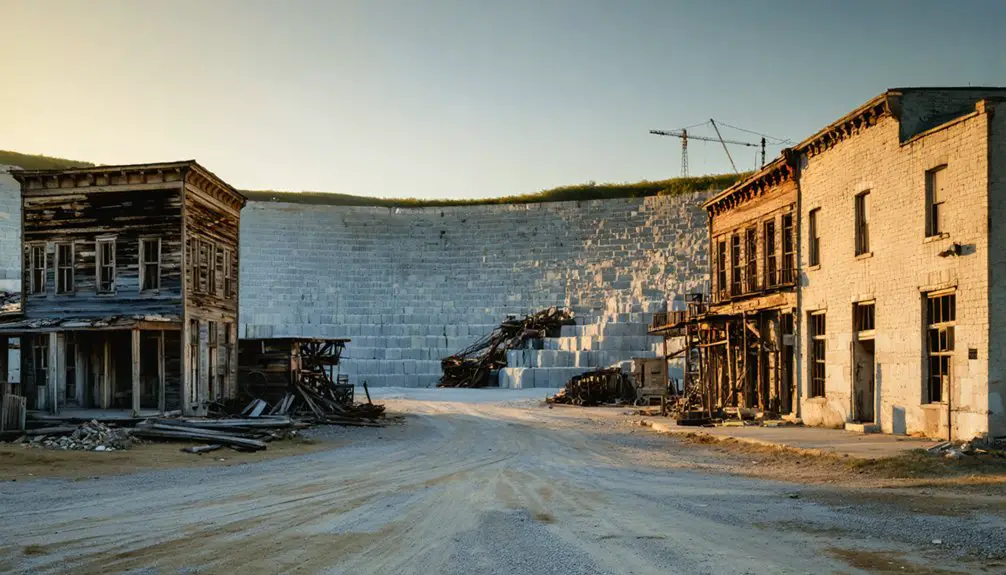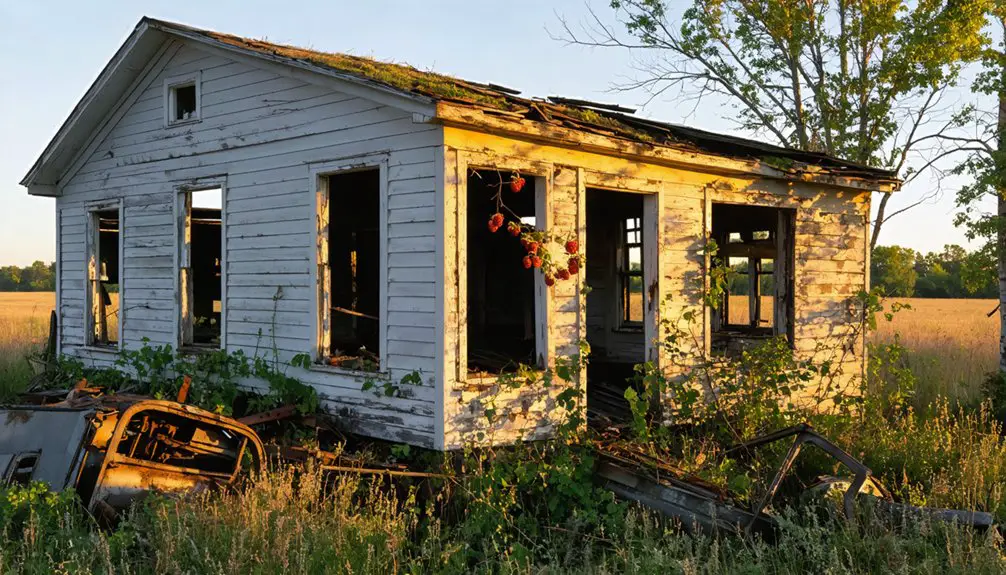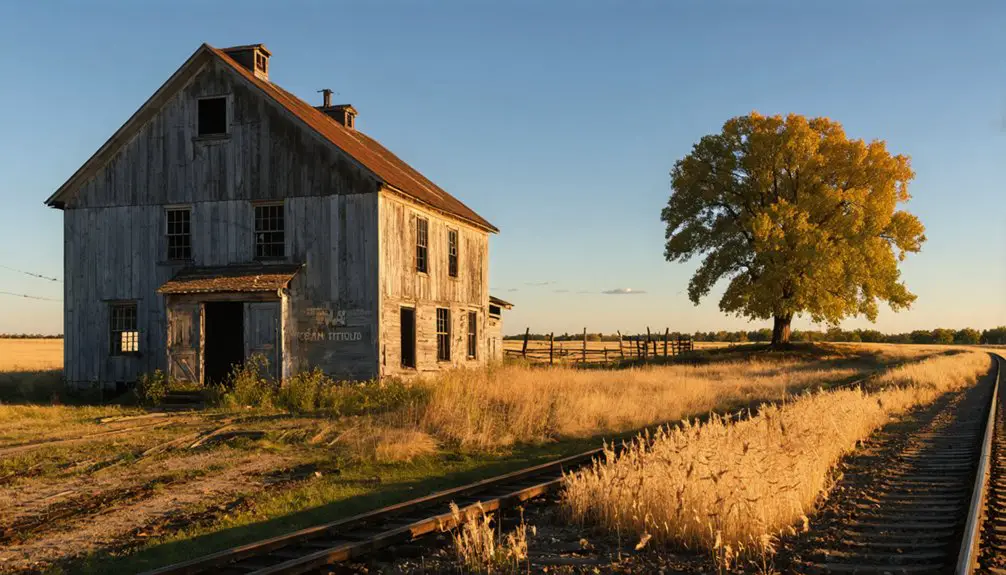You’ll find the remnants of Pitt, Minnesota along the Kettle River, where William L. Banning established a bustling sandstone quarry town in the 1890s. The community thrived with 300 residents, a railway depot, and workers’ homes surrounding the 60-foot quarry pit. By the early 1900s, economic shifts and market changes led to its decline. Today, nature has reclaimed the industrial site, transforming quarry pits into wetland habitats that tell stories of Minnesota’s mining heritage.
Key Takeaways
- Pitt was a Minnesota quarry town established in the 1890s by William L. Banning, centered around sandstone mining along the Kettle River.
- The town incorporated in 1901 with 300 residents and thrived on stone quarrying, producing 5,000 tons of stone in 1892.
- Economic decline began in the early 1900s due to market shifts toward cheaper materials and geological limitations of sandstone deposits.
- The community featured workers’ homes, a church, general store, and schoolhouse near a 60-foot-deep quarry pit.
- Nature has reclaimed the abandoned town, with former quarry pits becoming wetland habitats and vegetation overtaking stone structures.
The Rise of a Stone-Built Settlement
As Minnesota’s industrial development gained momentum in the 19th century, the settlement of Pitt emerged as a distinctive community built primarily from locally quarried stone.
You’ll find that the region’s abundant Sioux Quartzite deposits shaped not just the town’s architecture but its very identity. Early settlers quickly recognized the potential of these stone resources, developing specialized quarrying techniques that would transform raw rock into building blocks for their future. Stone flakes and tools found at nearby archaeological sites suggest a long history of human use of these mineral resources.
The town’s growth accelerated as transportation routes expanded, allowing stone shipments to reach broader markets. The arrival of railroad networks dramatically improved the transportation of quarried materials, mirroring the state’s broader economic growth through rail expansion.
Expert stone craftsmanship became Pitt’s hallmark, attracting skilled masons and quarrymen who brought their families to settle in the area. Their work created durable structures that stood in stark contrast to the wooden buildings common in neighboring settlements, establishing Pitt as a symbol of industrial ingenuity and resourcefulness.
Life in the Quarry Town
While stone quarrying dominated Pitt’s economy, daily life revolved around modest workers’ homes clustered near the 60-foot-deep quarry pit.
You’d find yourself in a tight-knit quarry community where families shared basic facilities and relied on each other for support. The labor challenges were intense – you’d spend your days cutting stone, blasting rock, or hauling materials, with your income fluctuating based on seasonal demands.
Your social life would’ve centered around informal gatherings in common spaces, with churches providing both spiritual guidance and community services. Native American tool-makers once used Grand Meadow Chert extensively in this region for crafting various implements. Archaeological evidence suggests this area served as a gathering place for villages from Red Wing, Blue Earth, La Crosse, and Upper Iowa.
Neighbors gathered in shared spaces while local churches served as both spiritual anchors and community hubs for quarry families.
You’d need to travel to nearby towns for schooling, healthcare, and shopping. The environment posed its own challenges – you’d face constant exposure to quarry dust and noise, while dealing with minimal sanitation facilities and unpaved streets typical of late 19th-century industrial towns.
William Banning’s Vision and Legacy
You’ll find William L. Banning’s grand vision for his namesake quarry town reflected in its careful 1890s planning, which included six streets and essential facilities to support hundreds of workers.
As a former president of the St. Paul and Duluth Railroad, he leveraged his railway connections to establish crucial transportation links for the stone quarrying operation. The bustling community grew to include several essential amenities, including a bar and motel.
While his dream initially attracted significant investment, including the Barber Asphalt Company’s relocation and the town’s 1901 incorporation, shifting market demands would eventually challenge the quarry town’s sustainability. The settlement reached an impressive population of 300 residents when it was officially incorporated.
The Quarry’s Early Promise
When William Banning established his sandstone quarry along the Kettle River in the early 1890s, he envisioned creating more than just an industrial operation – he saw the potential for a thriving community.
His strategic location along the St. Paul & Duluth Railroad spur positioned the venture perfectly for quarry expansion, enabling shipments of high-quality pink sandstone across the Midwest.
The early years showed remarkable promise. In 1892, the quarry shipped 5,000 tons of stone, while employment quickly grew to several hundred workers.
The emerging settlement demonstrated community resilience as housing, boarding houses, and other services sprang up to support the workforce.
With operations running from April through October and sales teams securing contracts year-round, Banning’s vision of a prosperous industrial town seemed within reach.
Like the nearby Kettle River Sandstone Quarry, the operation faced declining demand as cheaper materials like concrete began dominating the construction industry.
Dreams Meet Economic Reality
Despite William Banning’s ambitious vision and initial success, economic realities began undermining Pitt’s long-term viability by the early 1900s. His economic aspirations had attracted hundreds of workers and established crucial rail connections, but the town’s fortune rested precariously on a single industry.
You can trace Pitt’s decline through converging challenges. Geological challenges revealed that high-quality sandstone deposits weren’t as extensive as hoped. As easily accessible stone depleted, extraction costs soared. The quarry once employed 500 skilled workers to chisel rocks into construction blocks.
Meanwhile, the market shifted dramatically toward cheaper materials like steel and concrete. The devastating Hinckley fire of 1894 dealt another blow, destroying infrastructure and disrupting operations.
These setbacks, combined with broader economic downturns in the early 20th century, gradually eroded the quarry town’s foundation until its dreams of prosperity crumbled.
Daily Living in Northern Minnesota
If you lived in northern Minnesota during the early 1900s, you’d know the brutal winters demanded constant work gathering firewood, maintaining heat sources, and ensuring adequate food storage to survive until spring.
You’d find yourself joining neighbors for communal activities like barn raisings, quilting bees, and church socials that helped combat the isolation of long winter months. Many residents were self-employed individuals, as northern counties historically showed higher percentages of independent workers compared to urban regions.
Your daily routines would revolve around the practicalities of winter survival, from preserving autumn harvests to maintaining snow-packed roads that connected you to nearby communities.
Winter Living Challenges
The brutal winters of northern Minnesota posed extraordinary challenges for Pitt’s residents, with temperatures plummeting to −60°F and snowfall accumulations reaching 170 inches in extreme years.
You’d need robust winter survival strategies just to make it through the season, including maintaining constant heat sources and storing adequate supplies before roads became impassable.
Cold weather preparedness meant vigilantly protecting against frozen pipes, stocking up on fuel, and ensuring multiple heating options were available.
You couldn’t take chances with the shortened daylight hours and frequent blizzards that could trap you indoors for days.
Your daily routine would revolve around essential tasks: clearing snow, checking heating systems, and maintaining emergency supplies.
Every venture outside required careful planning and proper layering to avoid the very real risks of frostbite and hypothermia.
Community Social Life
Social life in Pitt revolved around four key institutions: the community church, general store, schoolhouse, and railway depot.
You’d find community gatherings centered around the church’s services, picnics, and funerals, while the general store served as your daily hub for news and mail pickup until its closure in the late 1900s.
The schoolhouse hosted plays and meetings before consolidation, and the railway depot connected you to the outside world through regular whistle stops.
Your social networks expanded during logging seasons when crews gathered in town, creating a bustling atmosphere of shared meals and storytelling.
Summer brought church potlucks and hymn sings, while the town lots hosted seasonal fairs.
As institutions closed and railway service declined, you’d increasingly rely on automobiles to maintain connections in nearby towns like Baudette.
The Stone Industry’s Peak Years

During Minnesota’s late nineteenth century, stone quarrying reached unprecedented heights as railroad expansion and nationwide construction demands fueled intensive extraction of the state’s rich deposits.
You’d find skilled stonecutters and laborers working the quarries near transport corridors, using drill-and-blast quarry techniques to extract prized Kettle River sandstone and regional granites.
Stone transportation relied heavily on James J. Hill’s expanding railroad network, which connected quarry towns to distant markets across the country.
James J. Hill’s railroads formed vital arteries transporting Minnesota stone from remote quarries to America’s booming cities.
The industry peaked in the 1880s-1890s for sandstone and continued strong into the early 1900s for granite.
You could see the bustling activity at quarries near Sauk Rapids and St. Cloud, where crews produced everything from massive building blocks to street cobblestones, feeding the nation’s growing appetite for quality Minnesota stone.
Economic Shifts and Town Decline
While mining operations initially brought prosperity to Pitt, economic vulnerabilities emerged by the early 1900s as the town’s dependence on extractive industries left it exposed to devastating commodity cycles.
You’d have seen the town’s economic resilience tested during both World Wars when labor shortages hit as miners enlisted or sought wartime employment elsewhere.
The Great Depression dealt another blow, with mine closures and limited capital for rehabilitation.
Natural Reclamation and Present State

If you visit Pitt’s quarry ruins today, you’ll find nature has steadily reclaimed the stone structures, with native willows and aspens breaking through old foundations and concrete.
The former quarry pits now hold water, creating wetland habitats that attract diverse wildlife including woodland birds and small mammals.
Over decades, mosses and lichens have colonized the exposed stone surfaces, while seasonal rains fill the abandoned excavation sites, transforming this once-industrial landscape into a naturalized environment.
Nature Reclaims Stone Ruins
As decades passed after Pitt’s abandonment, nature began systematically reclaiming the ghost town’s stone ruins through relentless weathering processes. Minnesota’s harsh freeze-thaw cycles gradually broke down exposed stone surfaces, while vegetation took hold, with roots and moss accelerating the decay.
You’ll now find the ruins largely engulfed by mature forest, where natural processes have transformed the once-bustling town into a wild landscape.
The stone structures’ ecological impact has evolved considerably. The ruins now serve as microhabitats supporting diverse flora and wildlife, while helping reduce erosion and improve local hydrology.
What remains visible is heavily weathered and fragmented, covered in dense undergrowth. The site exemplifies nature’s persistent power to reclaim human-built environments, returning them to their natural state.
Wildlife Among Quarry Remains
Since the quarry’s abandonment, diverse wildlife communities have transformed Pitt’s industrial remains into thriving habitats. The flooded quarry pits now host fish and amphibian colonization, while dragonflies dart above the water’s surface.
You’ll find frogs and toads breeding in shallow pools where marsh vegetation has taken root along the edges.
On the quarry’s rocky outcrops, snakes and turtles bask in the sun, while specialized lichens slowly claim the stone faces.
The disturbed areas have become home to grassland birds and small mammals, taking advantage of early successional plants.
Most remarkably, oak-savanna patches support cavity-nesting birds, and if you look carefully, you might spot prairie orchids and prickly pear cactus – evidence of nature’s resilience in reclaiming these industrial ruins.
Cultural Heritage in Lake of the Woods
While the ancient Canadian Shield forms the geological foundation of Lake of the Woods, its cultural heritage spans thousands of years of human history.
You’ll find Indigenous traditions dating back at least 5,000 years, with Paleo-Indians tracking mammoths along prehistoric shorelines. Historical artifacts reveal the sophisticated Laurel Culture’s burial mounds and the Old Copper Complex’s early metalworking from 3,000 BC.
By 1688, European explorer Jacques De Noyon arrived, followed by Pierre La Verendrye’s fur trading expedition in 1732. The region’s story continued through logging booms, the devastating 1910 fire, and resilient rebuilding efforts.
From early French explorers to devastating fires, Lake of the Woods has weathered centuries of dramatic transformation and rebirth.
Today, you can explore this rich heritage at the Lake of the Woods County Historical Society museum, where both Native American and settler histories come alive through carefully preserved exhibits.
Exploring Pitt’s Remnants Today

Today, you can explore the ghostly remnants of Pitt along Minnesota State Highway 11, west of Baudette in Lake of the Woods County. Your ghost town exploration begins at the intersection with County Road 6, where you’ll find the most prominent historical landmark – a boarded-up general store that once advertised “knives and wild rice.”
This building, dating back to 1901, originally served as Herbert and Mamie Sanborn’s home before becoming a store.
North of the tracks, you’ll discover the still-active Pitt community church, while the old schoolhouse, now a private residence, stands west of the general store with its original water pump visible.
The site’s railroad heritage remains evident through the whistle stop and former pulpwood lot, offering glimpses into northern Minnesota’s pioneering past.
Northern Minnesota’s Ghost Town Legacy
Throughout the late 1800s and early 1900s, Northern Minnesota’s landscape became dotted with numerous temporary settlements that would eventually fade into ghost towns. You’ll find their stories tied to railroad bypasses, depleted iron ore mines, and exhausted timber resources.
Within just decades of their founding, many towns saw rapid decline as economic forces shifted and populations moved away.
Today, you can explore these forgotten places through regional tourism initiatives and ghost town preservation efforts. Some sites, like former mining communities along the Iron Range, still display industrial artifacts and building foundations.
Others have been reclaimed by nature, with only old railroad grades and cemetery stones marking their existence. These remnants serve as compelling evidence to Minnesota’s boom-and-bust heritage, particularly in the northern counties where resource extraction once drove settlement patterns.
Frequently Asked Questions
What Happened to William Banning After Pitt’s Decline?
You won’t find direct records of William Banning’s fate after Pitt’s decline, though his legacy lived on in St. Paul, where he remained until passing away, leaving behind his railroad empire.
Were There Any Notable Accidents or Deaths at the Quarry?
You won’t find documented quarry accidents or deaths in available records for Pitt. While safety measures likely existed, historical records don’t reveal specific incidents of injury or loss at this site.
What Types of Stone Were Specifically Quarried at Pitt?
Like treasure hunters of old, you’ll find quartzite was the primary stone quarried at Pitt. The quarrying techniques focused on extracting this metamorphosed sandstone, known for its exceptional hardness and durability.
Did Any Families From Pitt Remain in Lake of the Woods County?
You’ll find evidence that some Pitt families stayed in Lake of the Woods County, as shown by the converted schoolhouse residence and maintained church. The Sanborn family’s original building remained standing through 1993.
Were There Any Schools or Churches Established During Pitt’s Existence?
You won’t find records of schools or churches in Pitt’s history. While educational institutions were common in Minnesota ghost towns, Pitt likely didn’t last long enough to establish these community foundations.
References
- https://kids.kiddle.co/Pitt
- https://dbpedia.org/page/Pitt
- https://www.cbsnews.com/minnesota/news/how-a-ghost-town-was-turned-into-a-minnesota-state-park/
- http://freepages.rootsweb.com/~gtusa/history/usa/mn.htm
- https://bringmethenews.com/life/places-to-visit-in-minnesota-the-eerie-ghost-town-of-north-hibbing
- https://en.wikipedia.org/wiki/History_of_Minnesota
- https://bigstonecounty.gov/county-history/ancient-civilization/
- https://www.startribune.com/unearthing-our-prehistoric-past/103626994
- https://mn.gov/admin/archaeologist/the-public/mn-archaeology/prehistoric-period/index.jsp
- https://www.nps.gov/miss/learn/historyculture/river-of-history-chapter-7.htm



